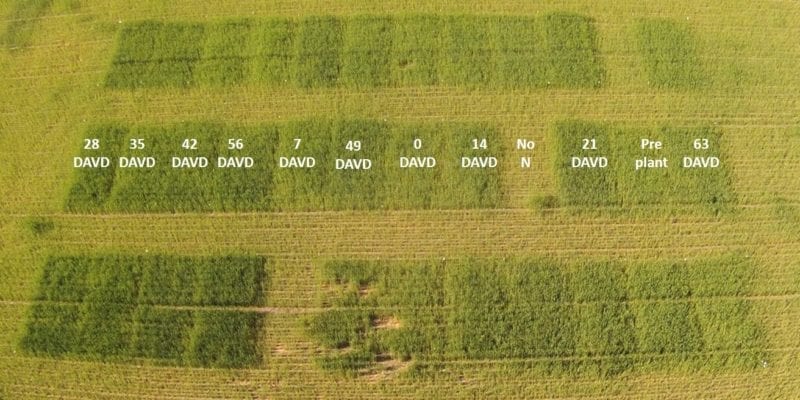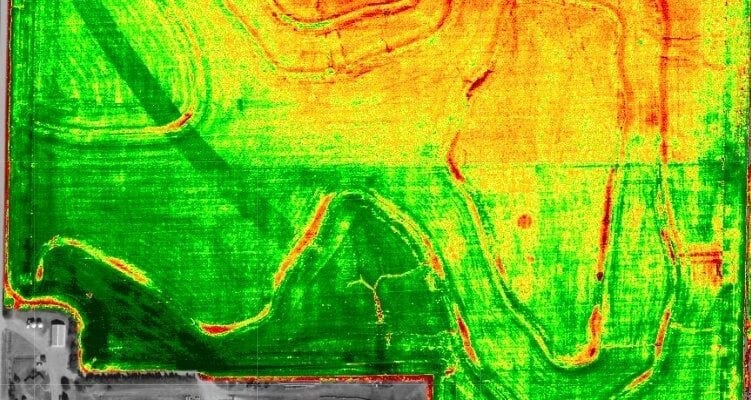The role calibrated imagery plays in your fertility ROI Using dirty data when trying to…

Maximizing Yield and Optimizing Protein for Your Wheat Crop
Nitrogen rate and timing can make or break protein quality
Protein is one of the many attributes that determine winter wheat end-use quality and marketability. Variety, nitrogen management and environment are a few factors that can significantly impact final grain protein content. Low protein is an indicator that nitrogen availability or uptake was limited during grain fill and brings limitations when it’s time to go to market.
Adequate fertility management using sensor-based technologies is needed to know exactly when and how much nitrogen to apply to get an adequate protein boost. Past yield data and soil tests won’t suffice in getting precise nitrogen timing and application amounts. A recent soil test can only tell you how the soil is currently performing; however, it does not account for any weather changes that have happened since the testing, which impacts how much nitrogen is currently in the soil. Implementation of N-Rich Strips and Trimble’s GreenSeeker hand-held crop sensor enables a more precise methodology that data can be collected, then used in our system to get a protein boost with a last-minute nitrogen recommendation.
PAST DATA WON’T PROVIDE PRECISE DATA
The optimum nitrogen rate for cereal crops changes dramatically and spatially across the field and from year-to-year. So, to optimize yield year-after-year, nitrogen recommendations need to be responsive to spatial and temporal variability. Using N-Rich Strips applied at planting, or shortly after, gives you a greater decision-making window, helps reduce production system costs and provides environmental benefits by avoiding over application.
To get more precise data requires the implementation of an N-Rich Strip and GreenSeeker. The N-Rich Strip is the field’s way of communicating to you if and when nitrogen needs to be applied. If a strip is visible, then the field is telling you, “Yes, I need nitrogen.” At that time, data collected with the GreenSeeker will help provide a variable rate nitrogen recommendation via our system, Katana. If a strip doesn’t appear, then the field is letting you know, “Hey, I am good. I don’t currently need nitrogen, but thanks for checking.”
WHEN IT’S BEST FOR TOP-DRESS
Research has shown that delaying the application of any nitrogen until late in the season, past hollow stem, will result in the best combination of yield and protein. Even when wheat is yellow and stunted, yields and quality can be maximized when nitrogen is applied at, or shortly after, hollow stem.
The image above shows a variety of N-Rich Strips from a 2016-2017 Oklahoma State University study on how long we can wait to apply nitrogen to get the best yield and protein.
Learn more about how late you can wait with this OSU delayed nitrogen study.
HOW TO GET THE BEST PROTEIN BOOST WITH A LATE APPLICATION
Late applications, at flowering, in the right environment, could increase protein by 2%. However, in the wrong environment, it could reduce yield due to burning. If you’re looking for a protein boost, ensure the weather is cool and humid to reduce burn potential. The nitrogen rate must be high enough to actually impact protein levels.
For every 1% of protein concentration, there is 0.1 pound of nitrogen per bushel. So, to increase the protein content of a 60-bushel wheat crop by 1%, six pounds must be converted from fertilizer to protein. To apply this much nitrogen without burning the crop, use UAN (28-0-0) and water at a 1:1 ratio at a total of 15-20 gallons per acre, and avoid spraying when it’s hot and windy with low humidity.
Learn more about application options and results in this OSU managing protein study.
THE NINJA WAY
In a nutshell, managing nitrogen to maintain protein and maximize yield comes down to making sure nitrogen is available at critical growth periods. With wheat, the critical uptake stage is typically between hollow stem and soft dough. When it comes to making sure nitrogen is available during this peak need, the only way we can do this is by applying just before it’s needed. This means a split application – one at pre-plant and one at green-up or early spring. The only way to ensure nitrogen is applied when the crop needs it is by implementing an N-Rich Strip.
By implementing this methodology and pairing it with our corrected NDVI imagery and nitrogen recommendation solutions, you can get more precise recommendations when the field tells you it needs it.
If you have questions on how to get a protein boost in your fields this season without losing yield, contact our agronomist, Tyler Lynch at tlynch@ninjaag.com. He can help you get started with the right approach for your area.
Check out this video with Dr. Brett Carver, OSU Wheat Breeder, to get an idea of baking and milling companies’ wheat characteristic expectations.
SOURCES
OSU NPK Website
OSU NPK Blog



